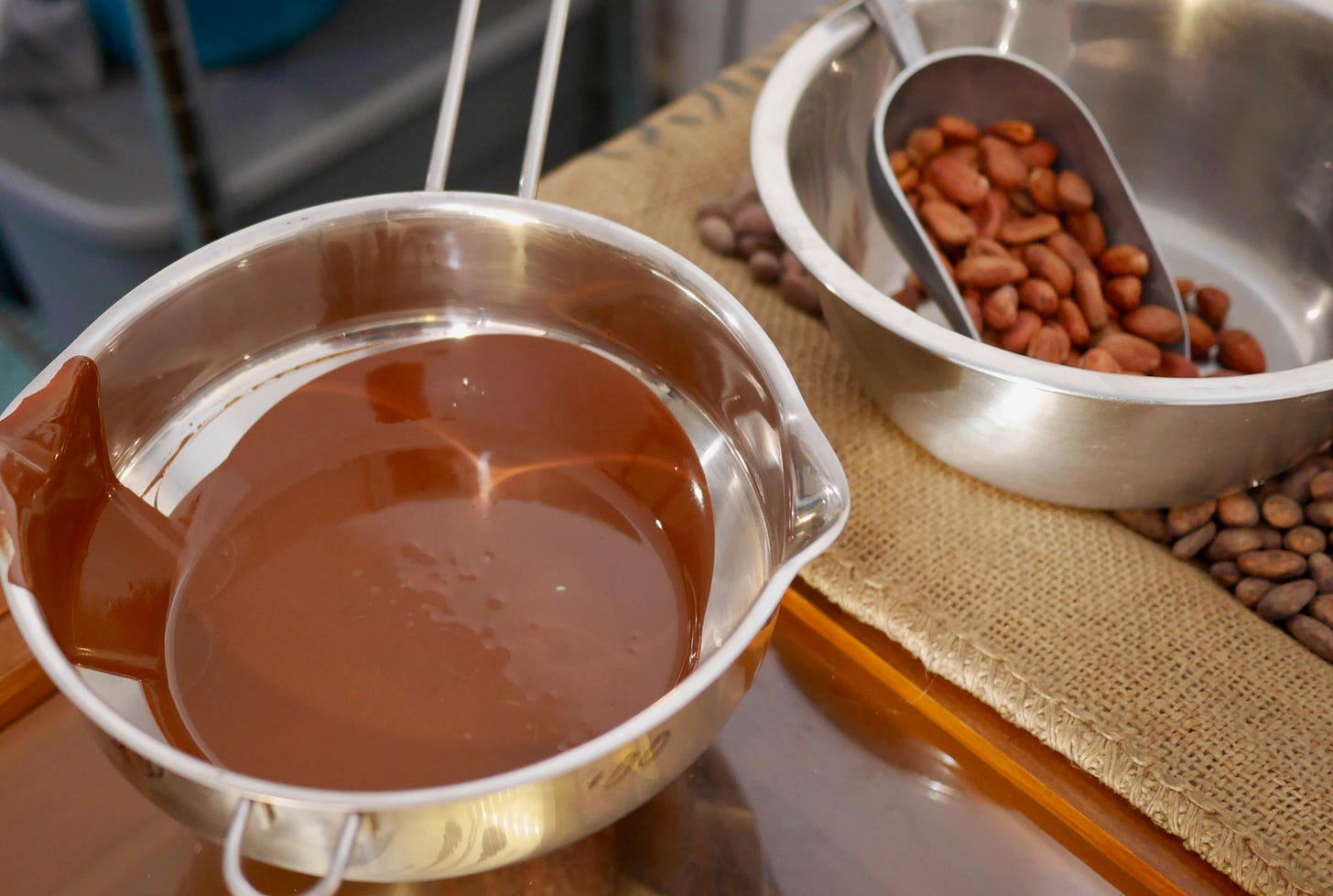Good Chocolate is our Friend
We look at two studies measuring the benefits of one of my favorite fermented foods
We make our living writing about fermentation and as things continue to improve on the pandemic front, teaching people how to ferment. This month Kirsten and I taught in Oaxaca Mexico (Vinegar and Hard Cider respectively) with a number of fermentation teachers from all over the world. After three days of intense fermentation learning I think we were all pretty fried, so its interesting that what has really stayed with me since was a couple of days later, when a friend connected us with a local chocolate maker. I wrote a piece at the Fermentation School about what we learned from Antonio about the journey from bean to bar. I was going to write more about the multi-stage fermentation process and the microbes involved but on the way there I came across to studies on the health benefits of chocolate that fascinated me and I hope they will you. If nothing else you will think differently about those packets of just-add-water cocoa…
The short of it
Two double-blind studies measured the effects of sustained consumption of various levels of cocoa flavanols. In one 8-week study of 90 lucky elderly Italians, three levels of cocoa flavanols were administered in powdered drinks taken once a day. They found improved cognitive function, improvements in insulin resistance, and lower blood pressure in those who received high levels of cocoa flavanols. Really high - more later.
The second 4-week study of 22 British participants also provided the mystery cocoa packets of various flavanol levels but was looking at what that did to the microbiota of the participants’ guts. They found that the higher cocoa flavanol consumption resulted in more bifidobacteria and lactobacilli in the colon and lower counts of clostridia. It would seem both studies lead to the conclusion that the more cocoa flavanols the better.
The long of it
You have undoubtedly seen the quick news articles about red wine or chocolate being recently found to be good for us. Something about antioxidants or whatever, all we remember is red wine and chocolate are good. Like all simple good things, it is not that simple really. If you stop reading here take away that if you eat a pile of dark chocolate daily you can expect to have a better mix of gut biota and better cognition if/when you are elderly.
Dark matters
First off there is double to triple the level of cocoa flavanols in that dark chocolate bar than its milk chocolate cousin. That said, finding the level of flavanol in your favorite chocolate bar, or any chocolate bar is frustrating at best. On the high end, 100% cacao, let’s use 15 mg of flavanols per gram, which is what several sites pointed to the ConsumerLab findings for Baker’s unsweetened 100% cocoa baking chocolate. The alter eco “Total Blackout” bar I just ate half of writing this piece is 75 grams for the full bar and 490 calories but I only ate half, weighing in at maybe 562 mg of cocoa flavanols. Milk chocolate can give you a lot fewer flavanols for the same calories so do your homework.
Highs are not created equally
The British study of prebiotic benefits used two levels: high at 494mg per drink and low at 23 mg per drink. Interestingly the Italians upped that game dramatically when they were looking at cognition for the elderly. They had three levels: 48mg for the low level, 520 mg for the intermediate level, and a whopping 993 mg for the high level. That’s full-bar-mode right there. No wonder those on the high level completed their memory tests so much faster than everyone else. Okay that’s not fair, we haven’t gotten to the details yet. Let’s look at each one at a nerd level.
Study 1: Wait, why am I here?
In the Italian study, 90 elderly subjects were recruited in the L’Aquila district of central Italy. To make the cut you had to have no cardiovascular disease, no neurological disorders, no inflammatory diseases, no thyroid disorders, no dementia. Besides all that all the smokers were booted, along with habitual users of vitamins C and E, anyone on medications that have antioxidant benefits like statins, or anyone who consumed chocolate on a daily basis. Amazingly they found 90 and for eight weeks these folks dutifully opened a blank package, mixed it with warm water and downed it. Then it was the day of the evaluation. These cognitive tests had also been administered at the beginning of the trial and the same neuropsychologically trained research assistants were paired with participants to remove any observation bias. While their scores were similar the time it took to complete the tests was significantly shortened for the high and intermediate-level consumption groups (think full dark bar and half dark bar) compared to the low-level group (Hershey kiss group?) which is interesting. Verbal fluency also improved for the high and intermediate groups in comparison with the low groups. Blood pressure dropped for high and intermediate groups as well while low groups remained relatively the same as before the study. Significant drops in diastolic blood pressure were observed.
“Together, these findings suggest a restorative effect of habitual flavanol consumption on different expressions of cognitive disfunction. Consistent with emerging epidemiologic evidence, these data also suggest that regular flavanol consumption may be protective against the development of age-related cognitive disfunction.”
Study 2: I’m eating it for them
If that first study doesn’t give you enough reason to make chocolate a daily indulgence how about if it’s not for you but for them?
The British study was a bit more of a commitment. 4 weeks consuming either a low or high (intermediate if comparing to the first study) and then 4 weeks washout, followed by 4 weeks of the other level of flavanol. Also fecal, blood, and urine samples were collected at multiple points along the way on this one.
They found no significant changes in blood pressure but like the first one a significant lowering in total cholesterol concentrations. Lower triacylglycerol levels were only recorded after the higher flavanol treatments. Okay, let’s head to the back end to understand what changed in the GI tracts of these folks.
No significant differences for Bacteroides spp. or E. coli for either treatment. However, high flavanol consumption consistently resulted in significantly larger populations of Bifidobacterium spp., Lactobacillus and Enterococcus spp. High flavanols led to significant decreases in C. histolyticum group but that same group increased under the low flavanol diet.
So what does this mean? Well, Lactobacillus spp. in our guts are one of our good guys (mostly because they outcompete pathogens), so feeding them specifically is generally a good thing too. Also, most prebiotics hasn’t shown any positive effect on LAB, so this could be important. Bifidobacterium spp. is a bit of the same story, a good guy for among other things outcompeting pathogens so increasing their numbers is also a good thing. What about that C. histolyticum finding? Remember that high levels reduced these guys but a low level saw them increase. Their bacterial group includes Clostridium pefringens, which is on our list of known pathogens and associated with colon cancer and inflammatory bowel disease. A few less of this group is also a good thing in my book.
Final summary
You made it this far so as a reward here is a picture of the melted chocolate from our visit and it did smell as good as it looks here. Now I know I should have done what I wanted to do then and drop my face right in there and start slurping.
References:
Daniela Mastroiacovo, Catherine Kwik-Uribe, Davide Grassi, Stefano Necozione, Angelo Raffaele, Luana Pistacchio, Roberta Righetti, Raffaella Bocale, Maria Carmela Lechiara, Carmine Marini, Claudio Ferri, Giovambattista Desideri, Cocoa flavanol consumption improves cognitive function, blood pressure control, and metabolic profile in elderly subjects: the Cocoa, Cognition, and Aging (CoCoA) Study—a randomized controlled trial, The American Journal of Clinical Nutrition, Volume 101, Issue 3, March 2015, Pages 538–548, https://doi.org/10.3945/ajcn.114.092189
Xenofon Tzounis, Ana Rodriguez-Mateos, Jelena Vulevic, Glenn R Gibson, Catherine Kwik-Uribe, Jeremy PE Spencer, Prebiotic evaluation of cocoa-derived flavanols in healthy humans by using a randomized, controlled, double-blind, crossover intervention study, The American Journal of Clinical Nutrition, Volume 93, Issue 1, January 2011, Pages 62–72, https://doi.org/10.3945/ajcn.110.000075







